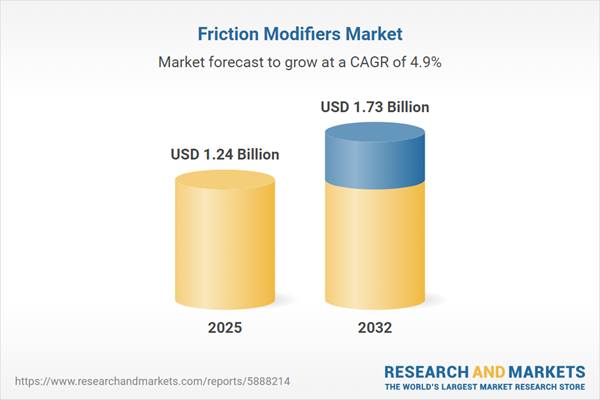Speak directly to the analyst to clarify any post sales queries you may have.
Friction modifiers drive progress in equipment reliability and operational efficiency, enabling organizations to extend asset lifespan and minimize downtime as industries increasingly emphasize resilience, sustainability, and regulatory adherence.
Market Snapshot: Friction Modifiers Market Overview and Growth
The friction modifiers market is expanding rapidly as advancements in nano-engineered and bio-based formulations attract investment across transportation, machinery, and energy segments. From 2024 to 2025, the market increases from USD 1.18 billion to USD 1.24 billion, with projections indicating continued growth to USD 1.73 billion by 2032, supported by a CAGR of 4.91%. Ongoing innovation meets sector-specific goals for asset longevity, regulatory compliance, and advanced maintenance strategies. Heightened global standards and evolving executive mandates are fueling development of tailored solutions, reinforcing the market’s role in organizational performance and operational reliability.
Scope & Segmentation of the Friction Modifiers Market
This analysis equips leaders with a comprehensive segmentation framework, supporting informed procurement, investment, and market positioning decisions across the following dimensions:
- Type: Ceramic-based additives, composite formulations, oil-based solutions, polymer-based compounds, and solid modifiers meet varying enterprise lifecycle requirements and operational strategies.
- Chemistries: Aluminum oxide, silicon carbide, carbon-based technologies, ceramic-metal blends, metal-polymer compounds, mineral oils, synthetic oils, polyurethane, PTFE, silicone, boron nitride, graphite, and molybdenum disulfide deliver compatibility with modern industrial demands.
- Form: Emulsions (including oil-in-water and water-in-oil), liquids (mineral and synthetic oil-based forms), pastes (grease or wax), and powders (such as graphite or molybdenum disulfide) enable versatile lubrication and protection solutions tailored for distinct technical use cases.
- End-Use Industry: Aerospace, automotive, energy and power, industrial machinery, and marine sectors demand unique applications, influenced by sectoral regulations and operational expectations.
- Application: Uses span corrosion protection in coatings, friction reduction in mobile systems, and improved wear resistance for discrete parts such as bearings, valves, and seals—each critical to minimizing failures and maximizing performance under stress.
- Regions: Americas, Europe, Middle East & Africa, and Asia-Pacific provide diverse demand patterns, with varying regulatory landscapes, regional growth priorities, and compliance environments shaping strategic approaches.
- Companies: The Lubrizol Corporation, Afton Chemical Corporation, Infineum International Limited, Chevron Oronite Company LLC, BASF SE, Croda International Plc, Innospec Inc., Evonik Industries AG, Emery Oleochemicals LLC, and Italmatch Chemicals S.p.A. are profiled for their innovation pipelines, global presence, and partnering strategies.
Key Takeaways for Strategic Decision-Makers
- Emerging nano-engineered and biological friction modifiers are reshaping durability and sustainability benchmarks within key industries, influencing both maintenance approaches and asset value protection.
- Regulatory changes are accelerating the adoption of advanced additive technologies, advancing compliance and environmental performance simultaneously.
- Digitally enabled monitoring is driving greater precision in deployment and predictive upkeep, empowering leadership to optimize critical infrastructure management.
- Customization is increasing as end users seek specialized materials—such as ceramics in aerospace or advanced lubricants in automotive and machinery—to match operational reliability goals.
- Supply chain flexibility and regional production investments are enhancing procurement agility and supporting stable sourcing in response to fast-changing global conditions.
- Collaborative initiatives and acquisitions focusing on digital transformation and sustainability targets are influencing supplier strategies and competitive market positioning.
Tariff Impact on Global Competitive Dynamics
Recent United States tariffs on materials and finished friction modifiers are prompting a reassessment of sourcing strategies among manufacturers. Companies are increasing reliance on regional and tariff-exempt suppliers, encouraging investment in local manufacturing, broadening procurement channels, and building more resilient supply chains. As a result, organizations benefit from stabilized costs and enhanced responsiveness to shifting trade landscapes.
Methodology & Data Sources
Findings are drawn from primary interviews with industry experts, exhaustive technical literature reviews, and regular monitoring of regulatory updates across major end-user sectors. Rigorous market mapping and triangulation methods ensure valid, actionable intelligence throughout the study.
Why This Report Matters
- Enables executive teams to align procurement and R&D investments with technological shifts, compliance demands, and evolving sustainability objectives in the friction modifiers sector.
- Provides actionable segment-level clarity for targeted product deployment and prioritization of opportunities in dynamic growth markets and regulatory environments.
Conclusion
Leaders can rely on this market research for robust guidance as they optimize operational strategies and build resilience in the friction modifiers space. These insights are designed to support best practice adoption and strategic adaptation to ongoing market evolution.
Additional Product Information:
- Purchase of this report includes 1 year online access with quarterly updates.
- This report can be updated on request. Please contact our Customer Experience team using the Ask a Question widget on our website.
Table of Contents
3. Executive Summary
4. Market Overview
7. Cumulative Impact of Artificial Intelligence 2025
Samples

LOADING...
Companies Mentioned
The key companies profiled in this Friction Modifiers market report include:- The Lubrizol Corporation
- Afton Chemical Corporation
- Infineum International Limited
- Chevron Oronite Company LLC
- BASF SE
- Croda International Plc
- Innospec Inc.
- Evonik Industries AG
- Emery Oleochemicals, LLC
- Italmatch Chemicals S.p.A
Table Information
| Report Attribute | Details |
|---|---|
| No. of Pages | 182 |
| Published | October 2025 |
| Forecast Period | 2025 - 2032 |
| Estimated Market Value ( USD | $ 1.24 Billion |
| Forecasted Market Value ( USD | $ 1.73 Billion |
| Compound Annual Growth Rate | 4.9% |
| Regions Covered | Global |
| No. of Companies Mentioned | 11 |









